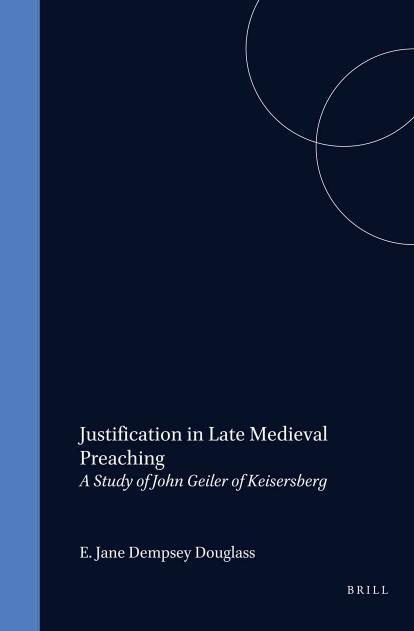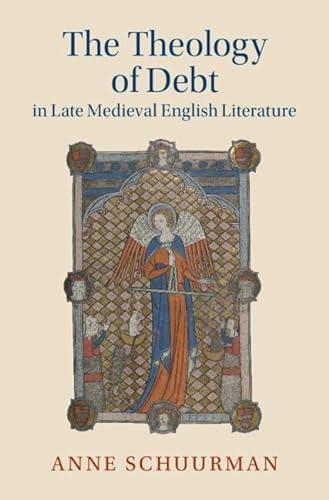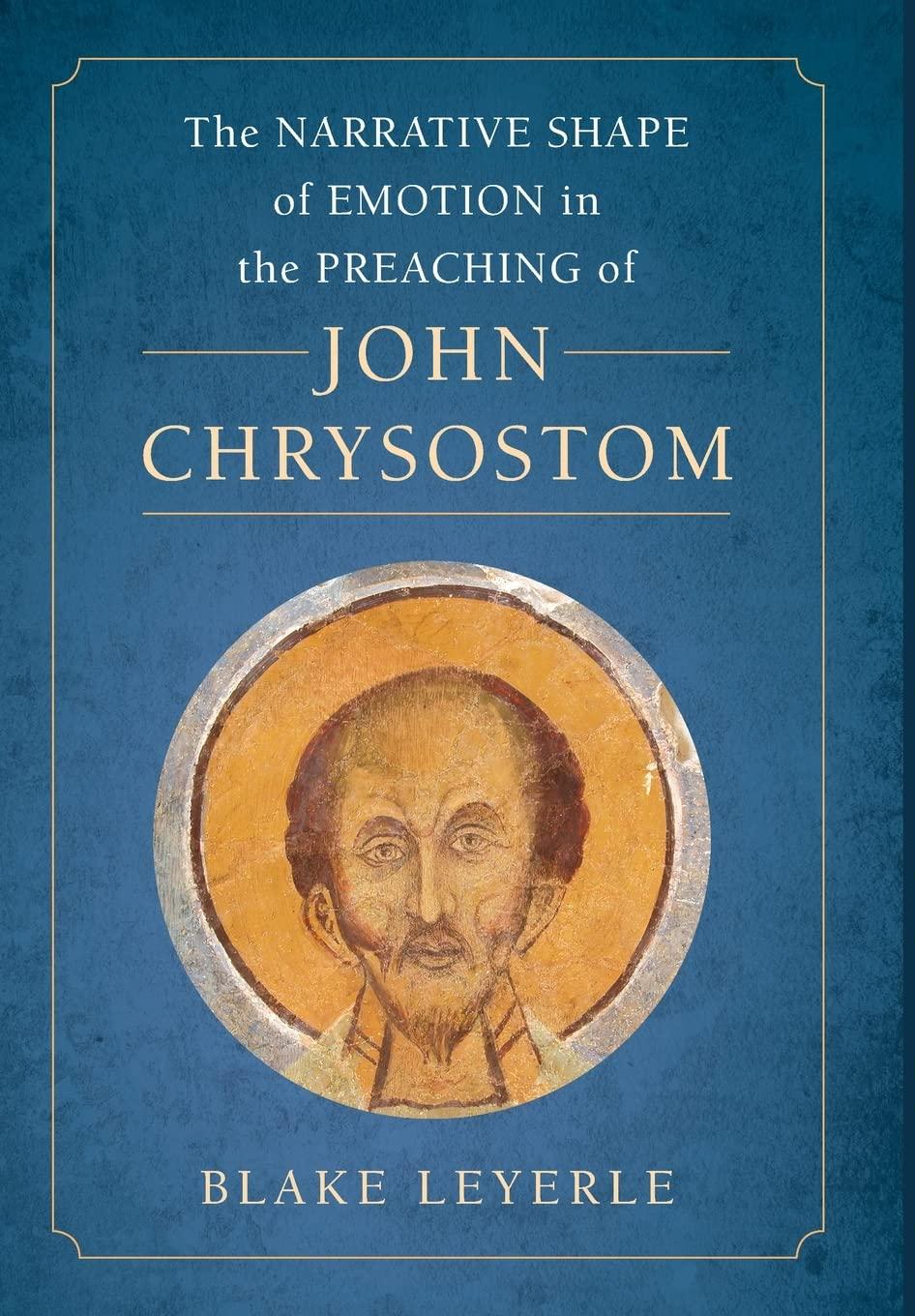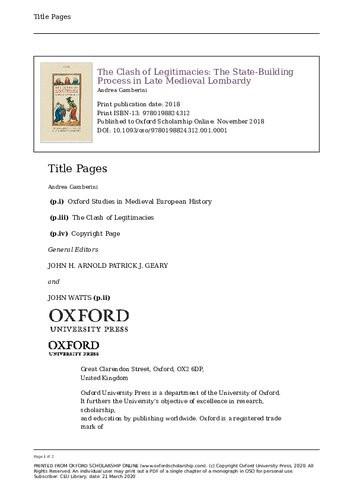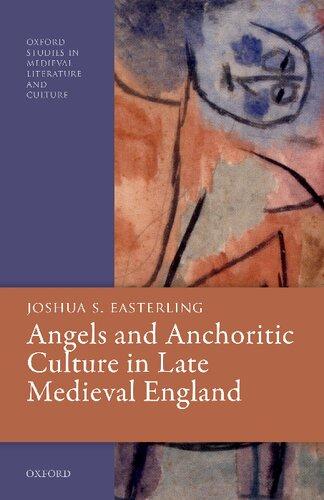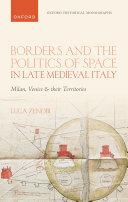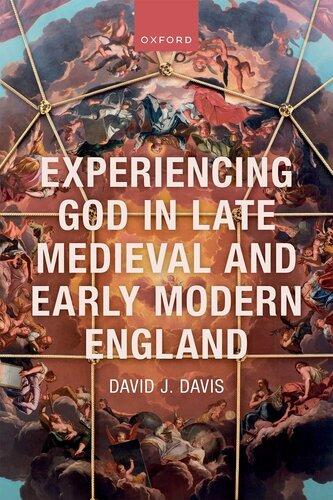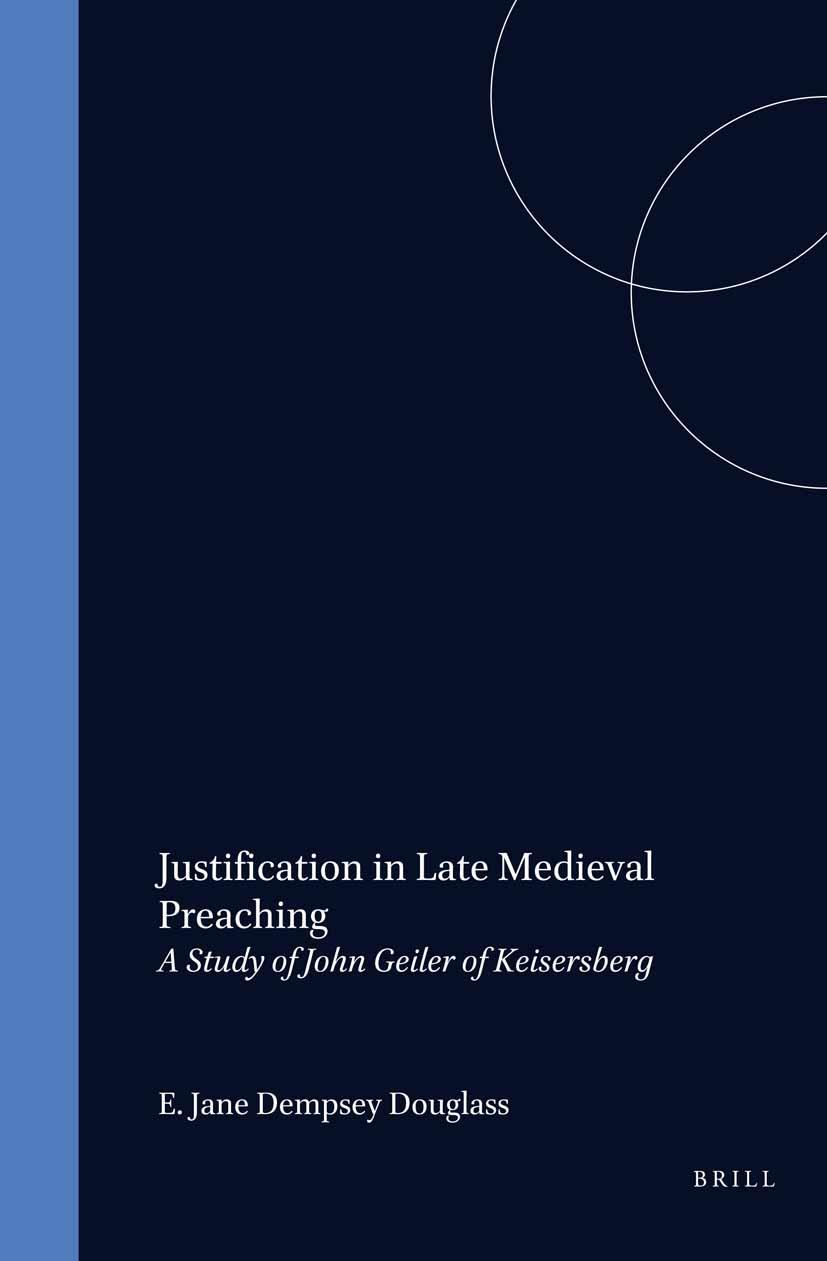GEILER AND LATE MEDIEVAL PREACHING
THE LATER MIDDLE AGES
Nominalism restudied.-A recent revival of interest in the theology of the later middle ages on the part of both Roman Catholic and Protestant scholars has made this period a most attractive one for research. Though the older stereotypes of the "barrenness" and "sterility" of late scholastic theology have been shown to be no longer tenable, the task of reconstituting our image of the period remains formidable.
Late medieval nominalism in particular has received considerable attention in the last three decades for several reasons. In the first place its dominant role in the fourteenth and fifteenth centuries justifies its careful analysis as an intellectual movement of major proportions. Though attention traditionally has been concentrated on the movement as a purely philosophical one, today the place of the nomiaalists in the history of theology is also receiving increased recognition. 1 Second, scholars of the Franciscan Order have undertaken serious study of the Occamist tradition and endeavored to show its essential orthodoxy. 2 Third, Luther scholars have become increasingly aware of the need to understand the nominalistic theology in which Luther was trained. s
In the effort to reconstruct the shape of the nominalistic tradition and to trace its influence on the thought of the later middle ages, we have been somewhat limited by the fact that nearly all the works available from men known to be nominalists are academic works such as commentaries on Lombard's Sentences, theological treatises,
1 Paul Vignaux, Justification et predestination au X/Ve siecle (Paris, 1934); idem, arts. "Nominalisme," DTC, XI, pt. 1 (1931), cols. 717-784, "Occam," ibid., cols. 864-899; H. A. Oberman, "Some Notes on the Theology of Nominalism," HT R 53 (1960), pp. 47 ff.; idem, The Harvest of Medieval Theology, Gabriel Biel and Late Medieval Nominalism (Cambridge, Mass., 1963).
2 P. Boehner, Occam: Philosophical Writings (Edinburgh, 1957); idem, Collected Articles on Ockham, ed. E. Buytaert (St. Bonaventure, 1958); G. Buescher, The Eucharistic Teaching of Wm. of Ockham (Washington, 1950).
3 Bengt Hagglund, Theologie und Philosophie bei Luther und in der occamistischen Tradition (Lund, 1955); Leif Grane, Contra Gabrielem (Gyldendal, 1962).
GEILER AND LATE MEDIEVAL PREACHING
lectures on the mass. Only from John Gerson and Gabriel Biel is there any considerable body of sermons preached to the people as well as to clerics. And yet it is of great importance to understand the influence of nominalistic pulpit-theology as well as that of the classroom. In fact significant questions in the area of Reformation scholarship demand exact knowledge of the nature of the theology actually being preached to the people by learned doctors of the Church as well as by indulgence sellers.
Our use of the term "nominalistic theology" requires some clarification. It has become increasingly clear that we must be alert to differenc.es in theological position among the nominalists. A preliminary attempt has already been made to distinguish several schools within nominalism. 1 Without overlooking the need to explore further this problem of classification, we find it useful in this study to use the term "nominalist" to refer to the dominant position, that of Occam and Biel.
Late medieval preaching.-In the light of all these considerations, we propose to explore the lively preaching tradition of the late fifteenth and early sixteenth centuries. Though the existence and significance of such a tradition in the later middle ages have been well documented by nineteenth- and twentieth-century scholars, 2 none of these scholars has been in a position to study the corpus of pulpit literature from
1 See Oberman, "Some Notes on the Theology of Nominalism," pp. 51-56.
2 Chr. Fr. von Ammon, Geschichte der Homiletik (Gottingen, 1804), vol. I; W. Wackernagel, Altdeutsche Predigten und Gebete aus Handschriften (Basel, 1876); R. Cruel, Geschichte der deutschen Predigt im Mittelalter (Detmold, 1879); P. Keppler, "Zur Passionspredigt des Mittelalters," H]B 3 (1882), pp. 285-315; 4 (1883), pp. 161-188; Kerker, "Die Predigt in der letzten Zeit des Mittelalters mit besonderer Beziehung auf das stidwestliche Deutschland," TQS 43 (1861), pp. 373-410; idem, "Zur Geschichte des Predigtwesens in der letzten Halfte des XV. Jahrhunderts", TQS 44 (1862), pp. 267-301; A. Linsenmayer, Geschichte der Predigt in Deutsch/and (Mtinchen, 1886); A. Lecoy de la Marche, La chaire franfaise au moyen age (Paris, 1886); F. Albert, Die Geschichte der Predigt in Deutsch/and bis f-,uther (Gtitersloh, 1892-6), 3 vols.; J. M. Neale, Medieval Preachers and Medieval Preaching (London, 1856); Pfander, The Popular Sermon of the Medieval Friar in England (New York, 1937); G. R. Owst, Literature and Pulpit in Medieval England (Cambridge, 1933); idem, Preaching in Medieval England (Cambridge, 1926); Florenz Landmann, Das Predigtwesen in Westjalen in der !etzten Zeit des Mittelalters (Munster, 1900); R. Petry, No Uncertain Sound (Phila., 1948); Y. Brilioth, Predikans Historica (Lund, 1945); E. Lengwiler, Die vorreformatorischen Priidikaturen der deutschen Schweiz (Freiburg, 1955).
For sermon structure see: T. Charland, Artes praedicandi. (Ottawa, 1936); D. Roth, Die mittelalterliche Predigttheorie und das Manuale Curatorum des]. U. Surgant (Basel, 1956); E. Gilson, "Michel Menot et la technique du sermon medieval,"
the standpoint of contemporary research into nominalistic theology. As we shall demonstrate below, certain of the most famous preachers of the period, such as Geller of Keisersberg and Michael Menot, now appear to stand in the theological line of Occam and Biel.
Methodological problems.-Several methodological problems encountered in the analysis of late medieval sermons must be pointed out.
(1) Very few critical editions exist; and where these are lacking, the question of textual authenticity must be raised. Sermons were normally delivered in the vernacular, then translated into Latin for publication. An effort must therefore be made to determine the history of the text, to evaluate the extent to which editors or translators may have influenced the content of the sermon as we possess it. 1
(2) In reading the secondary literature, one becomes extremely conscious of confessional bias. Books and articles are regularly written and evaluated in the light of the writer's own theological loyalty. This is clearly a period where both Protestants and Roman Catholics have a vested interest in the results of research.
(3) We lack a broad picture of theological teaching in the period. Some monographic literature has been published on particular figures, notably the German mystics and those who have been claimed as "pre-reformers", studies usually asking different questions than ours. As a result our information is fragmentary. Furthermore we know little about the lines separating the major schools and currents of thought in this period. Some light has been shed on the nature of nominalism at that time. But until we understand better the nature of contemporary Augustinian, Dominican and Franciscan schools of thought, we are in no position to draw clear contrasts or parallels.
(4) Much of the modern discussion of theologians of this period involves the question of their "orthodoxy." Unfortunately the criteria by which we can determine orthodoxy in the later middle ages are by no means clear. Though Roman Catholics are inclined to judge this matter by the canons of the Council of Trent, this procedure hardly seems defensible.
RHF 2. 3 (1925), pp. 301-60. See also bibliography appended to Petry, No Uncertain Sound.
1 For similar problems in dealing with medieval Jewish sermons, see Israel Bettan, Studies in Jewish Preaching: Middle Ages (Cincinnati, 1939), pp. 56-7. My colleague, Prof. Loren R. Fisher, has called this book to my attention.
GEILER AND LATE MEDIEVAL PREACHING
(5) Wide circulation of commonly-used collections of sermons and sermon illustrations makes it essential that a preacher's work be studied in sufficient depth to distinguish traditional material from the man's own theological position. An illustration of the difficulty is provided by a recent article dealing with preaching in Germany in the late middle ages. 1 The author has studied sermons on the parable of the Pharisee and the publican, and he calls attention to a common catena of quotations concerning the insufficiency of men's works taken from Scripture, Augustine, Gregory the Great, and Bernard which are regularly introduced in support of the posture of the repentent Publican. From this evidence he mistakenly concludes that this was teaching characteristic of the Augustinian friars prior to Luther, merely reflected in Luther's thought. The author has not noted that preachers who are at least semi-Pelagian in their theology can also quote such a catena in a context like that under discussion. His documentation is therefore unconvincing.
(6) We must keep in mind that an analysis of sermons may prove to be less revealing of the theologian's own position than a study of his more academic writings, and we seldom have the opportunity to compare the two aspects of a man's work as we do with Biel and Gerson, for example. Pastoral concerns certainly influenced the form of doctrinal presentations, 2 though we have as yet no evidence that it greatly altered the content. But we are warned of this possibility when Geiler comments concerning man's freedom to turn to God without special action on God's part that the view of Biel and Scotus seems more prudent than that of Thomas and Gregory of Rimini for preaching to the people, for it removes any occasion for their blaming God when they fail to receive grace. 3
THE CHOICE OF GEILER FOR INTENSIVE STUDY
In consideration of these difficulties in interpreting sermonic literature, it seems useful to open up such an area of research by making a study of the very central doctrine of justification in the sermons of
1 A. Zumkeller, "Das Ungeniigen der menschlichen Werke bei den deutschen Predigern des Spiitmittelalters," ZKT 81 (1959), pp. 265-305. a Biel emphasizes that school disputes are not to be paraded before the laity to offend their piety: III Sent. d 3 q 1 art. 1 nota 3. For Geiler, see p. 33 below.
3 (The opinion) " ... Scoti videtur mihi tutior ad predicandum populo: quia per hoc aufertur eis excusationis occasio/ qua dicere possent/ quod gratiam non consequimur/ est deus in culpa ... " Fruct. spir. 59rt.
a major preacher of the period who was recognized in his own day as a learned and orthodox theologian.
We propose to select for this purpose Dr. John Geiler of Keisersberg, preacher at the cathedral in Strassburg from 1478 till his death in 1510. Five major arguments for this choice can be advanced.
(1) Geiler was a renowned preacher of unusual!J wide influence in his day. Standard histories of German literature and culture as well as of the Church deal with his personal impact and his writings. Many scholars have claimed him to be the most significant preacher of his time. 1
Not only in Strassburg were his efforts to reform the life of society at large and that of the monasteries and clerics felt. He was also notably influential at Augsburg through his close association with Bishop Friedrich von Zollern, 2 formerly his pupil and a canon of the cathedral at Strassburg. There is also evidence of his influence at the imperial court, since he was a chaplain to Maximilian. 3 In 1503 Geiler was summoned to Fiessen for private consultations with the Emperor; while there he also preached to the court on the need for peace and justice. Geiler does not reveal the content of the private discussions, explaining that he was asked to hol.d it under the seal of the confessional. 4 The document which Geiler speaks of editing for Maximilian as the result of their consultation has been identified by some as a series of complaints against the Roman curia, 5 by others as a collection of precepts for the conduct of a good prince. 6 Rhenanus, speaking
1 W. Stammler, Von der Mystik zum Barock (Stuttgart, 1927), p. 252. Cruel, Predigt . .. , p. 538. Kerker, "Die Predigt. .. ," p. 271. J. Bolte, ed., Johannes Pauli, Schimpf und Ernst (Berlin, 1924), I, p. *16.
2 L. Dacheux, Un Riformateur catholique a la fin du XVe siecle. Jean Geiler de Kay.rersberg (Paris, 1876), pp. 362 ff. Cf. K. Stenzel, "Geiler von Keisersberg und Friedrich von Zollern," ZGO 79, NS 40 (1926), pp. 61-113; A. Steichele, "Friedrich Graf von Zollern Bischof zu Augsburg und Johannes Geiler von Kaisersberg," AGBA 1 (1856), pp. 143-172. See Geiler's letters of counsel to the young bishop in L. Dacheux, Die iiltesten Schriften Geilers von Kaysersberg (Freiburg i. Br., 1882), pp. 79-94.
3 Dacheux, Jean Geiler . .. , pp. 496 ff.; Charles Schmidt, Histoire littiraire de I' Alsace a la fin du XVe et au commencement du XVle siecle (Paris, 1879), I, pp. 368 ff.
4 See Geiler's letter to Wimpfeling from Fiessen in Dacheux, Jean Geiler . .. p. 496 n. 2; idem, Die iiltesten Schriften . , pp. 102-4.
5 Schmidt, Hist. litt .. . , I, p. 370. He cites as evidence a letter from Maximilian to Wimpfeling in 1510, preserved by Specklin. Though Specklin's Col/ectanea was destroyed in 1870, this letter is published by Rodolphe Reuss, "Les Collectanees de Daniel Specklin, architecte de la ville de Strasbourg," BSCMHA, 2d series, 14 (1889), p. 301.
8 Dacheux,]ean Geiler .. . , p. 497. Schmidt, Hist. litt ... , I, p. 370, also mentions such a collection of precepts written soon after the discussions.
GEILER AND LATE MEDIEVAL PREACHING
of the particular warmth with which Maximilian regarded Geiler, also refers to Geiler's compiling such a collection for the emperor. 1 Geiler's wide influence can to some extent be attributed to the fact that Strassburg in his day was one of the first cities of the Empire. There was already an impressive history of great preachers in the city: Albert the Great, Meister Eckhardt, John Tauler. But in the late fifteenth century, Strassburg experienced important economic expansion and political solidification. The period of Strassburg's greatness, which was to last into the mid-sixteenth century, had already begun. 2 The thriving printing industry in Strassburg in this period is particularly significant, since most of Geiler's sermons were printed and widely circulated.
(2) As a doctor in theology, Geiler was well-trained in the scholastic tradition. Before settling in Strassburg, he had been Dean of the Faculty of Philosophy (1469-70), Dean of the Faculty of Arts (1474), and lecturer on the Bible and Lombard's Sentences at the University of Basel, where he received his doctorate in 1475. Returning to Freiburg in Breisgau, where he had received the bachelor's and master's degrees, Geiler lectured in theology and served as Rector of the University in 1476-77.a
(3) Geiler' s place in the main stream of the intellectual life of the dt.ry is indicated by his remarkable circle of friends. 4 At Basel he studied under the humanist teacher, Heynlin of Stein (Johannes a Lapide), generally claimed by scholars as a realist, who had left Paris when the via moderna regained its influence there. During these years he came
1 "Ob summam vero eruditiooem cum vite sanctimonia copulatam, ab invictissimo Imperatore Cesare Maximiliano benevolentia haud vulgari dilectus est . Sacratissimo Cesare precepta quedam collegi t, ad que se rex componere debeat ... " Vita Geileri, 152v2.
2 See F. Ford, Strasbourg in Transition: 1648-1789 (Cambridge, Mass., 1958), pp. 4-20.
3 For the years in Freiburg and Basel, see Dacheux, Jean Geiler . .. , pp. 25 ff.; Schmidt, Hist. litt , I, pp. 338 ff.; P. de Lorenzi, Geilers von Kaisersberg ausgewiihlte Schriften (Trier, 1881), I, pp. 3 ff.; R. Newald, art. "Geiler von Kaisersberg," Die Deutrche Literamr des Mitte!alters: Verfasser!exikon, ed. W. Stammler (Berlin, 1936), II, cols. 8-14; H. Mayer, "Johannes Geiler von Kaysersberg hauptsachlich in seinen Beziehungen zu Freiburg im Breisgau," Schau-ins-Land 23 (1896), pp. 1-17; documentation from university records in J. A. de Riegger, Amoenitates literariae friburgenses (Ulm 177 5), I, pp. 58-63.
4 De Lorenzi, .. . Schriften, I. p. 5; A. Renaudet, Pririforme et Humanisme a Paris pendant /es premieres guerre.r d' ltalie (1494-1517) (Paris, 1953), p. 94; Schmidt, Hist. litt.. ., I, p. 360; F. Schmidt-Clausing, "Johann Ulrich Surgant, ein Wegweiser des jungen Zwingli," Zwingliana 11 (1961), pp. 287-320, esp. p. 314.
to know well Sebastian Brant and Jacob Wimpfeling, early German humanists who later through Geiler's influence gathered in Strassburg, joined by Thomas Murner, Thomas Wulf, Ringman, Beatus Rhenanus, and Peter Schott. Also in the circle at Basel were Ulrich Surgant, author of the well-known preaching manual, the Manuale curatorum, and Christoph of Utenheim, 1 who was later for a time a canon in the cathedral of Strassburg, then became bishop of Basel.
Gabriel Biel, though somewhat older, was a friend over the years; it has been noted as particularly significant that Geiler, standing on the threshold of the new era, should have been so closely bound in friendship with the last of the great medieval scholastics. 2 Biel's counsel played an important role in two turning points in Geiler's life. As a young man, he was strongly dissuaded by Biel, Engeling of Braunschweig, and the elder Peter Schott, Ammeister of Strassburg, from undertaking the hermit's life and decided rather to accept the post as preacher at Strassburg. 3 Years later, when the city of Basel had invited him to take a similar responsibility as preacher there, Geiler was seriously inclined to accept the new position, feeling that he had not been greatly successful in Strassburg. Peter Schott, writing Biel for his judgment on a number of points, asked his advice as to whether Geiler should leave Strassburg. Biel firmly counseled him to remain. 4 Through Schott's correspondence, we also have evidence that Biel invited Geiler and Schott to attend the licentia of his brother. 5
1 Dacheux, Jean Geiler . .. , pp. 429ff.; Schmidt, Hist. litt .. ., I, p. 359.
2 M. Kerker, "Geiler und sein Verhaltniss zur Kirche," Historisch-politische Blatter 49 (1862), p. 285; cf. ibid., 48 (1861), p. 638; Newald, Verfasserlexikon, col. 10. Wimpfeling, Vita I. K. 155r2: " ... Gabriel byel summus theologus: cuius consilio (veluti sapientissimi patris) maxime nitebatur "
3 Otther writes concerning Geiler in his dedication of the Navicula penitentie: "Adeoque vitam secretiorem amavit: ut secum tacite deliberans: Eremum ipsum nisi a Gabriele buhel et Eggelingo prohibitus intrasset." Back of title page. See Dacheux,Jean Geiler .. ., p. 512: the reference to the dedication of the Nav.fat. is erroneous; Schmidt, Hist. litt .. ., I, p. 324; Wimpfeling, Vita I. K. 155r2: Engeling is not mentioned here.
4 Biel writes to Schott: "Omnibus circumstanciis pensatis omnimodis iudico expedire consulendumque fore ut in vocacione qua vocatus est maneat nee cedat subtilibus sathanae instigacionibus qua sub specie boni fructum verbi dei satagit impedire." Schott, Lucubraciunculae ornatissimae, ed. J. Wimpfeling (Strassburg, 1498), 145r. (Geiler collected Schott's letters for this edition published after Schott's early death: see Geiler's letter to Reuchlin, Dacheux, Die altesten Schriften .. ., p. 100.) Cf. Dacheux,Jean Geiler ., p. 417 n. 1, 512 n. 2; Schmidt, Hist. litt ... , I, p. 357. For Schott's own attempts to persuade Geiler to remain, see Lucubr. SOr-81 v.
6 Lucubr. 85 v. See Dacheux, Jean Geiler . . ., p. 393 n. 2, 394, 407 n. 1.
GEILER AND LATE MEDIEVAL PREACHING
John Eck, whom there is reason to relate to the nominalistic movement, 1 speaks with gratitude later on 2 of the deep impression which Geiler and his circle had made upon him during his years in Strassburg, where he was ordained to the priesthood. He mentions in the Chrysopassus 3 having consulted Geiler six years previously, which would have been 1508 1 the year of his ordination, on the question of the hope of salvation. In 1512 Eck published a German version of Geiler's Navicula penitentie. 4
(4) Hailed as a forerunner of the Reformation even in the sixteenth century, Geiler involves us directly in the question of the relation of reform movements of the later middle ages and the Reformation. Geiler was listed by Matthias Flacius in his Catalogus testium veritatis. 6
An interesting story which bears on Geiler's relation to the Strasbourg reformation appears to stem from the chronicle of the Protestant Specklin, writing in the mid-sixteenth century. Pope Adrian VI, troubled by sympathies for Luther in Strasbourg, wrote a letter to
1 J. Schlecht, "Dr. Johann Eeks Anfiinge," H]B 36 (1915), pp. 1-36. See esp. pp. 4, 8: " ... erkliirte er zuniichst die Sentenzen des Petrus Lombardus an der Hand der Kommentare, die Meister Wilhelm Occam und der Tiibinger Professor Gabriel Biel dazu verfasst hatten." The source cited by Schlecht, however, appears to be a wrong reference in this case.
2 "Anno vero 1508. Argentinae ordinatus sum sacerdos Luciae: dispensatione super minori aetate a sede apostolka legato obtenta: aucta tune fuit mihi familiaritas, quam cum optimis quibusque Rhenanis illo tempore contraxeram, Tilmanno Basiliensi. Jacobo Vuinphelingio (qui mihi antea Alberti magni librum de adhaerendo Deo dedicaverat, sicut et postea Aureoli epitome byblicum) Beato Rhenano, et Gebuilero Selestatensi loan. Kaiserspergio Theologo incomparabili, Thoma Vuolphio, Sebastiano Brant. Admiratione <lignum est, iuvenem, alienigenam, pauperem, familiaritatem, et amicitiam tot spectabilium virorum obtinuisse." Eck, Replica Io. Eckii adversus scripta secunda Buceri apostatae super actis Ratisponae (Ingoldstadii, 1543), 54 [O ii] A. See Schlecht, "Dr. Johann Eeks Anfiinge," p. 8.
3 "Patet: nam virtus spes non inclinat ad sperandum vitam aeternam, nisi per debita media a deo praefixa/ nobis notificata: alioquin iam non esset spes/ sed temeraria quaedam et futilis praesumptio. et in fine de peccatis in spiritum sanctum. Et istud ultimum doctor Ioannes Geiler Keiserspergius optimus vir consultus a me ante sex annos ad pulchrum dubium applicabit: cuius verba adhuc memori mente teneo: sed du bi um ad materiam nostram est impertinens/ idcirco transeo." Eck, Chrysopassus (Augustae, 1514), Centuria 6, dubium 24.
4 Das Schiff des Hei!.r ... (Strassburg, 1512). Cf. Eck's Chry.ropassu.r, Centuria 6, dub. 26: " ... per bonae memoriae virum Iohannem Geiler Keiserspergium divini verbi/ dum in vita erat, concionatorem mirificum, praeceptorem nostrum semper observandum, in navicula poenitentiae quam nos sub epitomate in formam capitulorum et quatuor partium redactam, multis resectis, compluribus additis, plaerisque mutatis. Kunegundi duci utriusque Baiorariae dedicabimus."
5 (Lugdun, 1597), II, p. 895.
the Senate of the city, delivered by Cheregati January 1, 1523, anathematizing Lutheran doctrine and insisting that heretical works be burned. The deputies of the republic to the Diet were charged by the Senate to reply. They began by disqualifying themselves as judges of heresy, but pointed out that long before Luther's day they had heard charges against the priests and monks, similar to those brought by the men accused of heresy, from Geiler. Though Geiler conferred with the bishops and the magistrate, reform was never accomplished. 1
Cheregati replied that the propositions of Luther had already been condemned, so there was no need to examine them. "As to Dr. Geiler, if what you affirm were true, he would have overstepped the limits of his powers, and his example would not justify what is going on in your city." 2
Two other passages which are much disputed are to be found in the chronicle of Specklin. These concern a prophecy which Geiler is reported to have uttered on two occasions-when the Emperor Maximilian was present at the cathedral sermon along with the bishop -announcing that God would soon send reformers who would be more successful in removing abuses. 3
1 "Nous sommes des hommes peu lettres, c'est aux savants a juger ce qui est relatif aux saintes Ecritures et aux heresies; jusqu' a present nous sommes restes membres de l'ancienne religion. Quant aux accusations portees contre Jes pretres et les moines par ceux qu'on taxe d'heresie, nous en avons entendu de semblables il y a plus de vingt ans, par consequent bien longtemps avant qu'il fut question de Luther. A cette epoque le D. Geiler prechait a la cathedrale, et souvent ii a eu des entretiens et des conferences avec feu l'eveque Albert, avec l'eveque Guillaume et avec le Magistrat, pour aviser aux moyens de porter remede a la vie desordonnee des deres, mais cela n' a servi de rien, il n'y a pas eu de reforme." Dacheux, Jean Geiler ., p. 499. Quoted from Marie T. de Bussierre, Histoire de l'etablissement du Protestantisme a Strasbourg et en Alsace d'apres des documents inidits (Paris, 1856), p. 98. De Bussiere refers to Wencker and Specklin.
2 "Quand au docteur Geiler, si ce que vous affirmez etait vrai, il aurait outrepasse ses pouvoirs, et son exemple ne justifierait pas ce qui se passe clans votre ville." De Bussierre, p. 99. This work disputes Protestant claims of extensive abuses in the later middle ages, pp. 25-27, and denies that Geiler is a pre-Reformer, pp. 27-31. Dacheux's omission of the second part of the story related here somewhat alters its effect.
3 "Lieben freund, vor einem halben iahr als ich habe streng gepredigt wider alle schandt und laster. . . und habe verhofft es solle alles abgestelt werden, so wird es nur mehr gestaerckt. Die ursach will ich euch melden. Da mich unser heiliger vatter der pabst und unser gnaediger herr, der bishoff zugegen, auch alle praeladen und hoffgesind nit recht verstanden haben, derohalben muss ich sie entschuldigen, clan ich habe hart darauff getrungen alle solche laster zu reformiren, so haben sie's verstanden sie sollen's devitiren (sic) und derohalben gehet alles noch so fort. Als ich aber unsern gnaedigen bishoff, Jesus Christus, recht berichtet habe, hoere ich, so wird er andre reformatoren schicken die es besser verstehen
GEILER AND LATE MEDIEVAL PREACHING
The reliability of Specklin's report is contested by the Protestant Schmidt. 1 Dacheux also recognizes the dubious authenticity of this report from the standpoint of critical historical scholarship; but he is prepared to accept the view that Geiler could indeed have uttered such a warning. For Specklin's image of Geiler is corroborated by other evidence of sixteenth-century recollections of Geiler as such a "prophet." 2 In general, however, these prophecies have been firmly rejected by Roman Catholic and some modern Protestant scholars, though enthusiastically espoused by older and less scholarly Protestant interpreters of Geiler. 3
Despite considerable interest in Geiler' s relation to the Reformation, no line of theological influence specifically on the Bucerian tradition or the radical reformation movements which flourished in the Strassburg area has been noted in the literature. 4
Geiler and the Roman lndex.-Scholars interested in Geiler in recent years have been generally puzzled by the discovery that he appears on the first Roman Index, published by Paul IV in 1559, in Class I, all of his works being prohibited. 5 Further examination of the Index reveals the fact that two of his works, the Sermones de oratione dominica and the Speculum fatuorum, appear in Class II under the name not of
werden. Sie sind schon mit der bullen auf dem weg; ich werd es nit erleben, aber eure viel werden's sehen und erleben. Da wird man mich gern haben wollen und folgen, aber da wird kein hiilff noch rath mehr seyn. Darum wolle iedermann dencken das es ausbreche. Koenig Maximilian hat am imbis, als bishoff Albrecht und andre mit ihm assen mit grossem ernst solches vermeldt und gewarnet, und <loch D. Kaysersbergers hoeflichkeit wohl moegen lachen." Specklin, BSCMHA 14 (1889), p. 292, from year 1492. Cf. similar prophecy, ibid., p. 297, from year 1504. These have been partly quoted in translation by Dacheux, Jean Gei/er . .. , p. 498; also Adolphe Schaeffer, "Un predicateur catholique au quinzieme siecle," Revue chritienne 9 (1862), pp. 212-13. Twentieth-century literature does not indicate that Geiler scholars are aware that these passages and many other important ones from Specklin have been preserved and published.
1 Hist. /itt .. . , I, p. 369.
2 Jean Gei/er ., pp. 498-499.
3 J.M. B. Clauss, "Kritische Uebersicht der Schriften iiber Geiler von Kaysersberg," HJB 31 (1910), pp. 485-519, passim.
4 H. Bornkamm, Martin Bucers Bedeutungfur die europiiische (Giitersloh, 1952), p. 11 speaks of the "Tradition innerlicher Frommigkeit" of the mystics and Geiler as preparation for the Reformation.
5 Die Indices /ibrorum prohibitorum des sechzehnten Jahrhunderts, ed. Fr. H. Reusch (Nieuwkoop, 1961: photo. reprint of Tiibingen, 1886), pp. 190-1. Geiler is listed both as Johannes Cheyserspergensis and J. Keyserspergius. The history of Geiler's relation to the Index apparently has nowhere before been traced in comprehensive fashion.
Geiler, but of their editor, Jacob Otther, 1 who also stands in Class I.2 Our exploration of the question of Geiler's relation to the Index has indicated that his sixteenth-century reputation as a "forerunner of the Reformation," coupled with the fact that Jacob Otther, his famulus who edited several important editions of his works, became a Protestant minister, seems responsible.
The career of Otther (d. 1547) provides an important clue to the riddle of Geiler's appearance and disappearance from the Index which we shall trace below. Otther, who had known the humanists Wimpfeling and Jodocus Galtz in Speier in his youth, became Geiler's secretary and priest to the convent of the Penitents of Mary Magdalene in 1507. After Geiler's death three years later, he continued his theological studies, becoming Licentiatus in 1517. By 1520-within ten years of the time he left Geiler's household and within seven years of the time he published his last edition of Geiler's works-Otther had become an enthusiastic follower of Luther. 3 As a reformer in Kenzingen, Neckarsteinach, Solothurn, Aarau and Esslingen, Otther at times experienced considerable opposition to his work, 4 but also notable success. 6 He published sermons, catechisms and confessions, a liturgy, prayerbook, and a Church order. 6 After Luther's warm response to the confession drawn up by Otther and the other Esslingen pastors in 1535, Otther accompanied Butzer and others in 1536 to Wittenberg to conclude an alliance with Luther. Butzer speaks highly of Otther. 7 Thus in the mid-sixteenth century, Otther had acquired a reputation as a Protestant reformer.
In the later of his two attempts to explain Geiler's presence on the Index, Reusch has suggested that it was Otther, the Protestant, who had been originally cited there; through his connection with Geiler's works, Geiler's name must then have been included. 8 As evidence for this hypothesis, Reusch points out that Conrad Gesner's entry on Otther in his Bibliotheca refers to Otther's collecting Geiler's sermons only on the Navicula fatuorum and De oratione dominica, precisely the
1 Ibid., p. 192: "Jacobi Ottheri Sermones. Item Speculum fatuorum."
2 Ibid., p. 190.
3 Bossert, art. "Otter, Jacob," in RE, XIV, p. 527.
4 K. F. Vierordt, Geschichte der Reformation im Grossherzogthum Baden, (Karlsruhe, 1847), pp. 171-5.
6 Bossert, RE, XIV, pp. 528-30.
8 Bossert, RE, XIV, pp. 527-30.
7 Bossert, RE, XIV, pp. 529-30. For Luther's letter, see WA BR VII, pp. 297-8.
8 Fr. H. Reusch, Der Index der verboten Bucher (Bonn, 1883), I, pp. 370-1.
GEILER AND LATE MEDIEVAL PREACHING
two volumes which are listed in Class II on Paul IV's Index. Furthermore Beatus Rhenanus' life of Geiler is referred to by Gesner in the same entry, and Rhenanus also is to be found in Class I on the Index. 1
One weakness of this hypothesis is that the spelling of Geiler's name on the Index does not correspond in either of the two listings to that of Gesner. Reusch had already rejected his own earlier suggestion of a possible connection between Flaccius Illyricus's Catalogus testium veritatis and the Index at least partially on grounds of the lack of correspondence in the spelling of Geiler's name. 2
Reusch's suggestion, however, has the virtue of explaining an otherwise very puzzling aspect of the story: Why should the Navicula fatuorum and the Sermones de oratione dominica-and only these-be listed in Class II? If Geiler had already been firmly placed in Class I, this entry would be unnecessary. And if one were to single out from all of Geiler's works those most likely to earn a place on the Index, the Navicula fatuorum might be mentioned; but several of the German editions would surely be more promising candidates than the Sermones de oratione dominica, which have never been criticized. This strange selection can, however, be reasonably explained by the assumption that the compilers of the Index worked from Gesner's Bibliotheca without any knowledge of the content of the works listed. Such a procedure would also explain the inability of the Commission on the Index at Trent to justify Geiler's inclusion on the Index of Paul IV.
At the Council of Trent in 1536, when the commission on the Index was considering necessary revision of Paul IV's list to remove some "pious and learned persons" mistakenly included, 3 Geiler was
1 "Diesen Artikel [of Gesner] hat P. [Paul IV's Index] sicher benutzt. .. " Reusch, Der Index , p. 371. See C. Gesner, Bib!iotheca universalis, sive Cata!ogus omnium scriptorum, I (Tiguri, 1545), 360v: "lacobus Ottherus Nemetensis claruit Argentorati anno 1509. collegit Ioannis Geiler Keiserspergii concionatoris Argentinensis Naviculam sive Speculum fatuorum. Adjecta est eiusdem Geileri vitae descriptio per Beatum Rhenanum. . . Sermones Ioanni Keisersper gii de oratione Dominica, ab eodem collecti, impresse sunt Argentorati ... " None of Otther's own writings is mentioned. In the entry of Geiler, 419v_42or, which is certainly based on Trithemius, Gesner lists Serm. var. tract., Nav. pen., Peregr., Oral. dom., Frag. pass.: "Ego titulos tantum legi in Catalogo Basiliensis officinae Hervagii." A similar entry on Geiler can be found in IV (Tiguri, 1555), 64 v1; this must be based on Trithemius' entry in Catalogus i!!ustrium virorum, in his Opera historica (Francofurti, 1601), pp. 170-1. There are at least nine references to Geiler in the volume dealing with theology, III (Tiguri, 1549).
2 Reusch, "Drei deutsche Prediger auf dem Index," A!emannia 8 (1880), pp. 24-25.
3 " ••• mir neben andern erzbischoven und bischoven vom concilio die burde aufgetragen ist, den cathalogum hereticorum et librorum prohibitorum zu uber-
striken from the list after consultation with the Cathedral Chapter in Augsburg. We learn this from the correspondence of Archbishop Anton Brus, chairman of the commission. 1 Only the Navicula jatuorum and the Scrmoncs de orationc dominica, edited by the "apostate" Otther, remained on the Index, apparently as an oversight. 2
When the Index of Pius IV, the so-called Trent Index, was published in 1564, Geiler was indeed passed over in silence: but Otther appeared in Class I and again in Class II as before. 3 As further evidence that Geiler had been officially cleared from the charge of heresy, it should be pointed out that the diocese of Munich in 1569 published the Trent Index, followed by a "most select list of authors from which a complete catholic library can properly be constituted;" there, along with the Fathers-and Gabriel Biel-stood Johannes Khaiserspergius. 4 It is difficult then to explain why Geiler should reappear in Class I sehen und etzliche bi.icher zu corrigieren. und hat sich die zeit her, so wir damit nun fast anderhalb jar umbgehen, befunden, das gleichwohl etzliche frome und gelerte personen nit wenig beschwert sein gewest auf bericht, so Paulus IV pontifex von innen eingenommen hat und gedachten indicem gestelt, wie dann <lurch uns irer etzliche aus der andern anzal und demselben indice liberirt sein " Briefe des Prager Erzbischofs Anton Brus von Muglitz 1562-63, ed. S. Steinherz (Prag, 1907). pp. 109-110.
1 "Ad praepositum decanum et capitulum Augustanum. Reverendi Domini et amid charissimi. Invenitur in haereticorum catalogo Romae sub felicis recordationis Paulo IV edito Joannes Kayserspergius in classe prima litera I bis positus, et multi ex nobis ad revidendum ilium indicem deputatis patribus dubitant, eum virum aliquid scripsisse quod a fide sit alienum, paucissimique sunt qui aliquid eius authoris unquam legerint. nos vero aliquando vidimus passim in Germaniae monasteriis praesertim sanctimonialium legi postillum sub eius authoris nomine Germanice editum. legimus etiam celebrem eius mentionem apud J oannem Eccium. properant nunc deputati patres ad finem indicis novi conficiendi, idque iussu s. pontificis et ss. concilii; quare a Dominationibus Vestris Reverendis, quae nobis viciniores sunt, et commoditate publici cursus per equos dispositos reliquis citius consulere possunt, petimus ut iudicium suum de Joanne Kayserspergio nobis primo quoque tempore aperire non graventur et postillum cum aliis, si quae ab illo scripta haberi possunt, hue ad nos mittant. nollet enim s. deputatio cuique fieri iniuriam sed tantum saluti legentium libros consulere. facient Dnes V. Rmae rem et se dignam et ecclesiae utilem, si quod res est eo citius significaverint. cupimus Dnes V. rectissime valere. Datum Tridenti 6 Septembris 1563." Ibid., p. 135. No official records of the proceedings of the Commission on the Index are available. Cf. CT., IX, p. 1104, n. 1.
2 Fr. H. Reusch, Der Index ... , I, pp. 370-1. Both Steinherz, p. 135, and Ludwig F. von Pastor, Geschi&hte der Piipste (Freiburg i. Br., 1920), VII, p. 302 (n. 3) mistakenly claim that only the Otther edition of the Navi&ula fatuorum remained on the Index, though both refer to Reusch, Joe. cit. Von Pastor appears dependent on Steinherz.
3 Die Indices librorum prohibitorum . .. , pp. 266, 269.
4 "Index selectissimum auctorum, ex quibus integra bibliotheca catholica institui recte possit." Ibid., p. 334; Biel, p. 333.
GEILER AND LAl'E MEDIEVAL PREACHING
in 1590 on the Index published by Sixtus V 1 and should stand there with the notation, "Trent Index," on all subsequent editions up to the general reorganization of the Index in 1900. Reusch calls this fact "scandalous," explaining that others removed at Trent were also reentered by Sixtus V; but most were stricken again by Clement VIII, Geiler being left by pure negligence. 2
Apparently Alsatians interested in Geiler were not aware of the fact that Geiler was on the Index until around 1880. Dacheux in his first volume, the biography of Geiler published in 1876, does not mention the fact, 3 nor does Schmidt, whose work was published in 1879. An article in 1880 announces that Geiler's work is forbidden as though this were a new discovery. 4 De Lorenzi, in the introduction of his translation of excerpts from Geiler' s works dated 1881, expresses his shock at having discovered the fact when his translation was nearly completed. 5 And the second volume by Dacheux, containing some of Geiler's writings and published in 1882, carries on its title page a notation that permission for publication had been granted by the Congregation of the Index. 6
De Lorenzi explains that he received permission from the Congregation of the Index to publish an emended (!) text, provided that Geiler's errors were explained in the introduction. This list of de Lorenzi's appears to be the only place where a Roman Catholic interpreter has attempted to spell out Geiler's theological errors. Others stoutly maintain his orthodoxy-. 7
Gei/er's alleged errors.-Because our choice of Geiler for study is so largely dependent on his reputation among his contemporaries for
1 Ibid., p. 489. Otther in Class I, p. 488; in Class II, p. 493.
2 Reusch, Der Index ... , I, pp. 371-2.
3 A footnote, p. 563 n. 1, refers to the two Otter editions being later put on the Index.
4 Reusch, "Drei deutsche Prediger auf dem Index," p. 24: "Es wird wol manchen Lesern der A/emannia neu sein, class Geiler von Kaisersberg auf dem Romischen Index der verbotenen Bucher stet, und zwar unter den 'Auctores primae classis' ... "
5 Schriften, I, p. v.
6 Die ii/testen Schriften
7 Dacheux, Jean Gei/er . .. , pp. 221 f. Dacheux does admit that Geiler failed to do justice to papal attempts to organize a crusade for which indulgence money had been collected, pp. 249 ff. Cf. Clauss "Kritische Obersicht .. .,"passim.]. G. Muller, KL, V, col. 194, merely refers to de Lorenzi. Stammler, Von der Mystik .. . , p. 254-5, has noted Geiler's presence on the Index, attributing it to his sharp words against the clergy. Von Ammon, Leben . .. , p. 40, doubts that Geiler's teaching on the Pope and indulgences is fully Roman.
sound doctrine and responsible teaching, it is essential to clarify the nature of the errors identified by de Lorenzi.
First, it is alleged that Geiler was overzealous in criticizing the hierarchy of the Church, particularly in questioning the papal right to suspend earlier indulgence bulls in announcing the Jubilee of 1500. 1
Second, during a famine in 1481, Geiler was reported to the city authorities to have told the poor from the pulpit to go into the houses of the rich to take the grain they needed, breaking in the doors with axes if necessary. This advice, de Lorenzi claims, goes counter to all morals. 2
The third concerns the Eucharist. De Lorenzi charges that it is erroneous and offensive to teach that the body of Christ received in the sacrament of the altar is not effective in the soul of the communicant through its own power, but that the body of Christ imparts grace to the communicant in a mysterious manner similar to that of the water of baptism. 3
Fourth, Geiler in the Peregrinus carries on a polemic against the teaching that in baptism both the theological and moral virtues are

1 " ••• von solchen anstosstgen Behauptungen, besonders von verletzenden Aeusserungen gegen kirchliche Oberen und Genossenschaften hat Geiler in seinem reformatorischen Eifer sich nicht stets frei zu halten gewusst." De Lorenzi, S chriften, I, p. 11. When Geiler was asked about the suspension of indulgences, he replied that ". . . Insbesondere, class es ein Betrug sei, wenn die Gliiubigen der wohl erworbenen Ablasse ohne Entschiidigung beraubt wurden; class durch diesen Verlust viele Seelen im Fegfeuer schwer zu leiden hiitten, und endlich, class, gleichwie der Papst nicht die Gewalt habe, ohne rechtmiissige Ursache Abliisse zu erteilen, er wohl auch nicht ohne rechtmiissige Ursache die erteilten widerrufen oder suspendiren konne. Hier geht Geiler offenbar viel zu weit, und, abgesehen von dieser irrigen Meinung, verletzt er groblich die dem Apostolischen Stuhle schuldige Erhfurcht, zumal da er diesen Gegenstand unter dem allgemeinen Titel, 'Fiilschung und Betrug' bespricht. " S chriften, I, pp. 12-13.
2 " 'Gehet hin in die Hauser der Reichen, welche Korn aufgespeichert haben; sind sie geschlossen, so schlaget die Thuren mit Aexten ein und nehmet euch Korn' usw. Es leuchtet ei:n, class eine solche Aufforderung, so gerecht auch der Zorn des Redners uber die Hartherzigkeit der Wucherer gewesen sein mag, gegen alle Moral verstosst." S chriften, I, p. 13. Quoted from Dacheux, Jean Geiler , p. 528.
3 "Irrig und anstossig ist drittens die in der Navicula Penitentiae IV L ausgesprochene Ansicht Geilers uber die Wirkungsweise des Altarssakramentes, wenn er die Frage, wie der Leib Christi die angegebenen Wirkungen auf die Seele des wurdigen Empfangers ausube, dahin beantwortet, class er diese nicht durch die ihm eigene Kraft hervorbringe, sondern class iihnlich wie bei dem Wasser der hi. Taufe, beim Empfange des Leibes Christi in geheimnissvoller Weise die Gnaden mitgeteilt wurden." Schriften, I, p. 13.
GEILER AND LATE MEDIEVAL PREACHING
infused. De Lorenzi argues that this is now commonly taught doctrine. 1
It is clear that de Lorenzi does not consider these sufficient grounds for Geiler to be placed on the Index. And it is significant that no Roman Catholic scholar seems to have used the occasion provided by the Church's condemnation of the writings to bring stronger evidence to question Geiler's essential orthodoxy.
In the case of de Lorenzi's first and third points, we will show in the appropriate chapters below that de Lorenzi has not properly understood the context out of which Geiler speaks. 2 With regard to the fourth, it is not clear either that Geiler has consistently refuted this teaching or that it is in fact a point on which the Roman Church has taken a dogmatic stand. 3
The second is not to be found in Geiler's sermons. Dacheux accepts the report as reliable, pointing to the mildness of the city councils' reaction as evidence of the gravity of the situation which provoked such an outburst of "charity" from Geiler. 4 Though there is no other evidence of Geiler's counseling social revolution-and much to the contrary-5, his constant admonitions to generosity toward the poor and his sharp blasts against the hard-hearted rich lend some credence to the account.s
1 " ••• in dem Peregrinus VIII Z van Geiler als gegen eine Neologie gefiihrte Polemik wider den jetzt als sententia communis geltenden Satz (vergl. Cat. Rom. 2.2.50) class in der hl. Taufe ausser den gottlichen auch die sittlichen Tugenden eingegossen werden." Schriften, I, p. 13.
2 See pp. 201-3 and pp. 187-9.
a See pp. 120-5.
4 Dacheux, Jean Geiler , pp. 528-9. The account from the Stadt-Ordnungen, XXIX, fol. 59: "Des doctors zum Munster rede halp als er in siner bredigen offentlich geret hat zu den armen der durung des korns halp: louffent den richen luten in ir huser die korn hant, ist es beslossen, slahent es mit einer ax uff und nebent korn an ain kerwe holtz, verlieren ir <las kerweholtz, kummen zu mir so wil ich uch sagen wie ir es verantwurten sollen und zu lest geret, <loch es ist noch nicht zit, wan es aber zit ist <las wil ich uch was sagen.
Des haben sich die Herren die XIII und XV underret uff meynunge gutlich mit im zu reden das im solicher swerer red in siner bredigen nit not gewesen sy, und in zu bitten fruntlich davon zu ston.
Su beduncken auch geraten sin, das teglich Ammeister und Ratherr mit den schoffeln uff siner stuben frunntlich und in geheim rede obe ire stube gesellen einer oder me sich des doctors red an neme <las sie in gutlich davon wisen uff gutlich wege die zu stuben dienen." Quoted by Dacheux,jean Geiler , p. 528 n. 2.
6 For example, his familiar complaint that no one is content to remain in his own place: "Sunt qui non contentantur terminis a deo sibi prefixis et mensura etc. sed super id tendunt. Agricola vult esse civis: civis nobilis: nobilis miles:" etc. Nav. fat. XXVII M. Cf. Nav. pen. 2vt.
8 Peregr. XVII G-H; Nav. fat. VII T - VIII C.
More characteristic of his response to a particularly pressing problem, however, is his handling of the desperate situation of the poor suffering from syphilis, in need of food and medicine. Day after day in his sermons comes the appeal for charity on their behalf. He even reassures the people that he himself will supervise the administering of these emergency funds. 1
Turning now to Geiler's contemporaries for evidence of their regard for the soundness of his teaching, documentation is readily at hand from those in his own circle of friends : Wimpfeling, 2 Beatus Rhenanus, 3 Brant 4 and Eck. 5
Though the poetic tributes to authors found on the backs of title pages are not to be taken with utter seriousness, it is interesting that here, too, the same emphasis on Geiler's zeal in proclaiming the divine law recurs, 6 along with his erudition and personal discipline.
1 Gem. spir. 35vt-2; 36v1; 37r1; 37v1, See Dacheux,jean Geiler .. . , pp. 522-8; L. Pfleger, "Das Auftreten der Syphilis in Strassburg, Geiler von Kaysersberg und der Kult des heiligen Fiakrius," ZGO NS 33 (1918), pp. 153-173; Pfleger, "Les origines de l'avarie a Strasbourg et le predicateur Jean Geiler de Kaysersberg," RCA 36 (1921), pp. 473-478.
2 " ••• veri dei oraculum ecclesie tuba/ non peccata nimium attenuans nee plus equo exaggerans in dicenda veritate nullius timens potentiam." Vita I. K. 153 v2. " ... imperterritusque/verax/ solidus/ constans/ fidei tenax integerrimusque fuit ... " Ibid., 154 v2.
3 "Floruerunt sane omni evo/ qui virtutes ceteris ardentius amplexati/ heroice vite non infimum vestigium attigerint. Ex horum numero nostra tempestate fuit Ioannes Geilerus Cesaremontanus ... " Vita Geileri, 151 v2. " ... quanta hie gravitate/ quanta simul authoritate tot annis populum edocuerit. .. " Ibid., 151 vi.
4 "Cum tua tangat opus praesens studia atque laborem
Hine titulo assigno id nominibusque tuis
Tu mihi praeceptor mihi tu pater atque magister
Tu patriae nostrae gloria fama decor
Te doctore parens nostra Argentina relucet
Hactenus et felix teque beata viget
Declamare soles, tua verba salubria discit
Plurima honestorum christicolumque cohors
Condo te plebis sequitus, tibi nomina ab inde Fausta tenes, plebis tu pater atque salus, Proinde tibi tribuat vitam Deus optimus illam
Quam populum cunctum verbo opere atque doces."
"Apostropha ad doctorem Keysersperg," in Sebastian Brants Narrenschijf, ed. F. Zarncke (Hildesheim, 1961: photo reprint of Leipzig, 1854), p. 184. See Geiler's epitaph by Brant, ibid., p. 154 in German, p. 195 in Latin. Compare the latter with Dacheux, Jean Geiler .. ., p. 506. See also poem dedicated by Brant to Geiler, Zarncke, op. cit., p. 183.
5 See above, p. 8.
6 "Argentina deo grates age/ plaude/ triumpha. Quod talem ac tantum digna es habere virum
